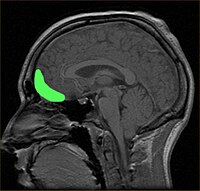
Photo from wikipedia
Trait impulsivity, a predisposition to respond to stimuli without regard for the potentially negative consequences, contributes to many maladaptive behaviors. Studies have shown that both genetic factors and interregional functional… Click to show full abstract
Trait impulsivity, a predisposition to respond to stimuli without regard for the potentially negative consequences, contributes to many maladaptive behaviors. Studies have shown that both genetic factors and interregional functional interactions underlie trait impulsivity. However, whether common genes contribute to both trait impulsivity and its neural basis is still unknown. This study investigated the phenotypic correlations between trait impulsivity and the resting-state functional connectivity (rsFC) of the amygdala as well as its subregions and the genetic contribution to the phenotypic correlations. By recruiting a sample of 292 twins in late adolescence and young adulthood, we found that trait impulsivity was positively correlated with the rsFC between the left full amygdala and the right dorsolateral prefrontal cortex (DLPFC). Further analyses on the subregions of the amygdala showed that trait impulsivity was positively correlated with the rsFCs between the left basolateral (BL) amygdala and both the right DLPFC and the right inferior frontal gyrus and with the rsFCs between the right superficial (SF) amygdala and both the dorsal anterior cingulate cortex and right anterior insula. Bivariate genetic modelling analyses found genetic overlaps between trait impulsivity and the rsFC of the left full amygdala or the left BL amygdala with the right DLPFC. The proportions of phenotypic associations accounted for by overlapping genes were 82% and 60%, respectively. These results provide evidence for the genetic overlap between trait impulsivity and the intrinsic brain functional connectivity centred at the amygdala and especially at its BL subregion.
Journal Title: NeuroImage
Year Published: 2019
Link to full text (if available)
Share on Social Media: Sign Up to like & get
recommendations!